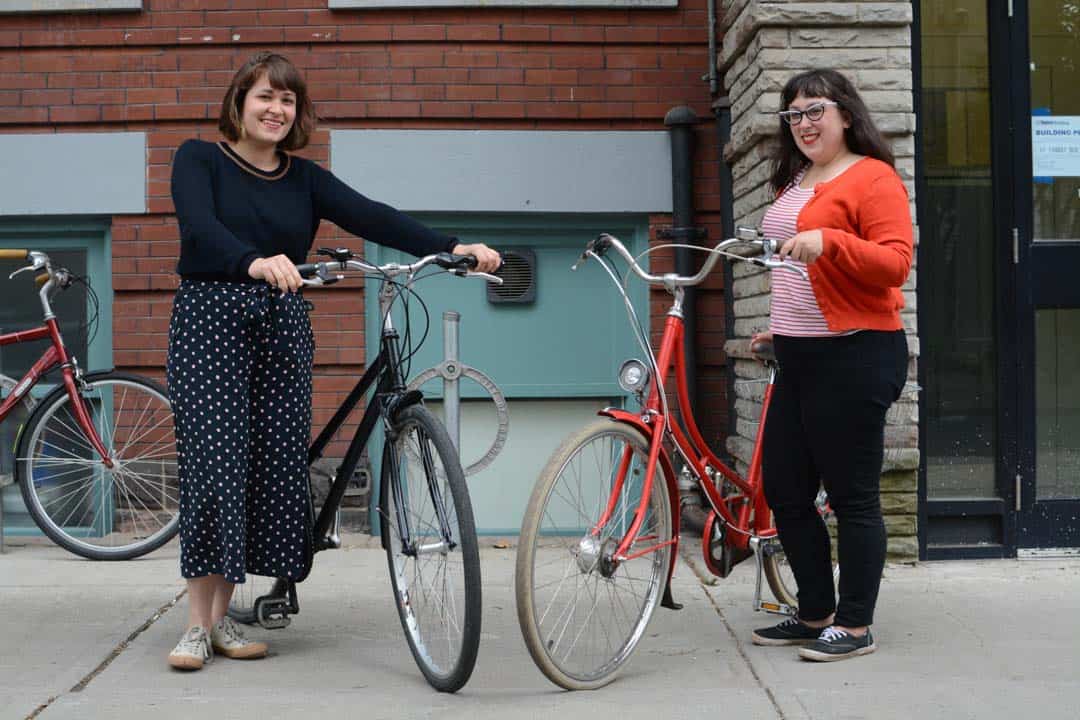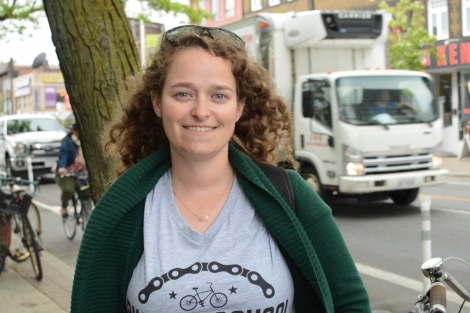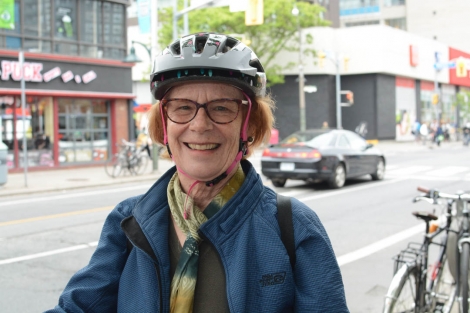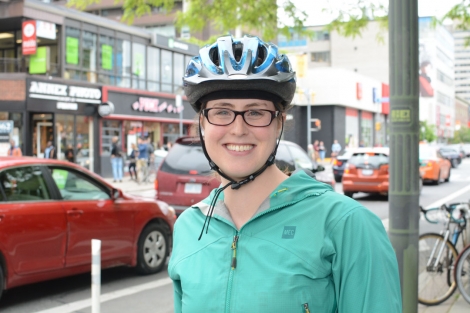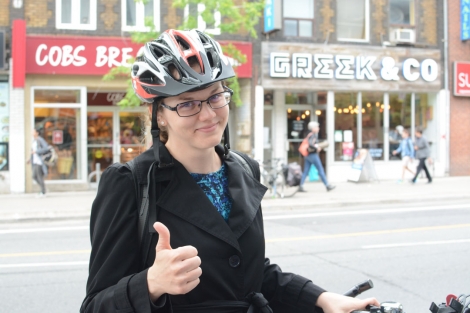[dropcap]C[/dropcap]ayley James and Rachel Lissner want to see more women cycling in Toronto. On June 15th, the pair will host “Taking the Lane: Gender and Cycling in Toronto” at the Parkdale Library. The event, which runs from 6:00–7:30 pm, is a panel addressing the problems that face Toronto’s cycling community with the ultimate goal of discussing a safer city for cyclists and encouraging more women to commute on two wheels. The event will be moderated by publisher Tammy Thorne, the founding editor of dandyhorse magazine, which dubs itself “Canada’s premier arts and culture magazine for cyclists.”
When James and Lissner spoke to their female family members and friends, they noticed that many had misconceptions about how unsafe cycling can be. These conversations served as inspiration for the event’s inception.
“I’ve been cycling around the city since I was 12 or 13 and I was essentially alone for a long time because my friends didn’t feel safe or they didn’t feel like it was a ‘girl’ thing to do,” James said. “And they still feel that way. I don’t cycle with a lot of my friends from high school. Most of them are probably scared or have preconceived notions of what is expected of them.”
According to Cayley and Lissner, many women choose more secure means of transportation to move around the city: public transit, Uber, or cars.
U of T graduate student Lina has biked in both Copenhagen and Toronto. “Maybe male [cyclists] are more aggressive,” Lina said. “Not to be stereotypical, but the cyclists on the road are angry.” The Toronto native believes this discourages females from cycling around the city.
Chantelle, an experienced cyclist, believes that the gender gap in the cycling community begins at a young age, when misconceptions about the physical strength of men in comparison to women have a tendency to develop. “What ends up happening is a lot of boys are encouraged to be active and get out there and play and girls are protected and held back from getting on a bike. Once that encouragement disparity occurs when they’re young, it becomes more likely when they get older that they won’t be riding as often as boys.”
Toronto’s lack of bike infrastructure poses a serious issue that is difficult to overlook. Poor lighting systems and the absence of designated lanes for cyclists on most streets are major issues that prevent individuals from cycling. While accidents are inevitable, the inclusion of bike lanes reduces the rate of injury by 50 per cent, and the inclusion of protected bike lanes reduces this by 90 per cent.
Judith, a 70-year-old lifelong cyclist, laments many of her experiences biking on the streets of Toronto. “I’ve cycled in 19 countries and Toronto is the worst, most dangerous [city] I’ve ever been to. And I’m a confident, experienced cyclist,” she said. “The first time I got doored, I thought, ‘I can’t believe this happened to me, this never happened in 118,000 kilometres of cycling.’”
The lack of bike lanes is especially problematic outside Toronto’s downtown area. Bike lanes on major city streets, like the separate pilot project lanes on Bloor St., have encouraged more women to cycle, as the prospect of distracted drivers has been removed from their immediate path. As one gets further afield in Toronto, however, bike lanes become almost non-existent, causing a great deal of inconvenience and decreasing a woman’s willingness to cycle.
“I was cycling before [the separate bike lane] but I definitely cycle on Bloor a lot more,” said Alyson, another Toronto cyclist. “[cycling at night] is similar to how safe I feel during the day, which is good for the most part but there’s probably one close call every ride I take.”
“In the downtown core, there seems to be a gender parity for cyclists. But when you go further afield when you go where bike lanes aren’t available, fewer women and girls cycle and that’s a huge thing,” James said.
The presence of bike-friendly streets in several European countries like Denmark, the Netherlands, and Germany encourages both men and women of different demographics to cycle. Not only do these countries have designated cycling lanes, but they also have spaces dedicated to parking thousands of bikes all over the city. Unfortunately, this is another aspect of cycling infrastructure that is absent outside of urban cores.
“We have an incomplete [infrastructural] grid,” Lissner, who holds an Urban Studies degree from U of T, added. “Cycle Toronto, for its 2014 mayoral campaign, was pushing for a minimum grid and we have seen a loss of bike lanes over the past few years. We’ve gained a few sharrows — which are lanes where bikes and cars share the lane based on the time of the day. It’s not really a bike lane and not something I would personally advocate for. You can’t get anywhere on a bike unless you want to stay in a specific part of the city, which is privileged and already well-served by several forms of transit and other healthy aspects of urban design like parks and open space.”
Cyclists in Copenhagen feel almost as safe on their bikes as North Americans feel in their cars. In the past decade, the city has invested $115 million USD in cycling infrastructure with the purpose of moving people, rather than cars, efficiently throughout the city. Bike lanes and boulevards are well-maintained, streets are well-lit, and parking spaces exist throughout the country. In addition, the Danish government has invested $36 million on ‘Bike Super Highways,’ which connect major urban cities with their surrounding suburbs and rural areas so that even trips between cities are safely accessible on a bike. Perhaps consequently, 55 per cent of all cyclists in Denmark are women.
“I felt completely safer [in Copenhagen],” Lina noted. “I would bike on the road without a helmet on in the middle of the night. I felt safer there — just to give you a contrast [to Toronto].”
Lissner and James stress the importance of cycling clubs in increasing women’s participation and encouraging them to explore the city on bicycles. As both noted, cycling in groups makes women and non-binary individuals feel safer and more confident on the streets, and builds communities to where they can discuss issues and possible solutions.
While there’s a lot to be done to improve the cycling environment in Toronto — especially regarding infrastructure and safety measures — events like “Taking the Lane,” led by cycling enthusiasts like James and Lissner, showcase an increasing interest in cycling and the development of bike-friendly streets.
“Taking the Lane” panelists include a quartet of U of T alumni: Alex Legum, a certified CAN-Bike and Professional Mountain Bike Instructor and a bike repair instructor; Siva Vijenthria, a bike columnist at Spacing Magazine; and Katie Wittmann, a published researcher, amateur triathlete, and former co-president of the University of Toronto Triathlon Club; in addition to moderator Tammy Thorne. The group is also accompanied by Ryerson Graduate Student and Bad Girls Bike Club co-founder Lavinia Tanzim.
Editor’s Note: The bios of Lavinia Tanzim and Katie Wittmann have been updated to accurately reflect their current and former professions and education.

